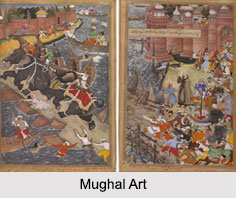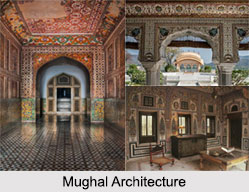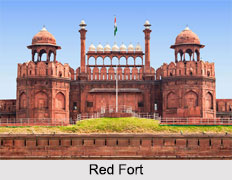 Developed between the 16th to 18th centuries, the Mughal art and architecture is an amalgamation of the Islamic, Persian, Turkish and Indian styles. The Mughal Dynasty was established in 1526 after the victory of Babur in the Battle of Panipat. Their rule marked the extensive displays of art forms, architectural styles that developed vigorously around that time.
Developed between the 16th to 18th centuries, the Mughal art and architecture is an amalgamation of the Islamic, Persian, Turkish and Indian styles. The Mughal Dynasty was established in 1526 after the victory of Babur in the Battle of Panipat. Their rule marked the extensive displays of art forms, architectural styles that developed vigorously around that time.
Features of Mughal Art and Architecture
The Mughal rulers built magnificent gates, forts, mausoleums, mosques, palaces, public buildings and tombs etc. One of the similar features of the Mughal architecture was the pronounce domes, the slender turrets at the corners, palace halls supported on pillars and the broad gateways. During the Mughal period, use of red sandstone and white marble was quite common in the construction of the buildings. In the later Indian architectural styles, Mughal architecture has been a great influence, including on the Indo- Saracenic style, Rajput and Sikh styles.
A fundamental feature of the Mughal art was manuscript illumination. A noteworthy example is Persian miniature painting. One of such painting shows a miniature figure of Emperor Akbar, holding a flower and carrying a sword by his side. The flower is symbolic of the calm and peace loving attributes of the Emperor, while the sword is suggestive of Akbar"s royalty and inherent bravery. These Mughal paintings were usually invested with rich imagery and profound meanings. During Humayun`s rule, the intricate illustration of Amir Hamza, a fabulous narrative produced 1400 paintings on cloth that were conducted by expert Persian painters.
 Mughal Art and Architecture under the Mughal Emperors
Mughal Art and Architecture under the Mughal Emperors
Under the patronage of the first 6 great Mughal Emperors, the Mughal art and architecture flourished and to this day their influence can be witnessed. Discussed below are the artistic contributions of some of the Mughal rulers:
Mughal Art and Architecture during Babur"s Era: The type of structures that evolved during Babur`s regime was not at all provincial or any kind of regional manifestation. Babur constructed several mosques around India, mostly taken from the desecrated Hindu temples. He constructed a series of buildings which mixed the pre existing Hindu particulars with the influence of traditional Muslim designs which was practiced in Turks and Persian culture. Mosques during Babur"s reign was only two, first was the Panipat Mosque, which is currently in the Karnal district of Haryana and the other one is the Babri Mosque in Faridabad district on the banks of the Ghaghara River.
Mughal Art and Architecture during Humayun"s Era: Humayun"s troubled reign did not allow him enough opportunity to use his artistic temperament to the fullest. Humayun constructed some mosques at Agra and Hissar and the palace of "Din-i-Panah" in Delhi which was probably destroyed by Sher Shah. Humayun also had a keen interest in art and the Mughal School of painting began in 1549 when Humayun invited two Persian painters to his court, who directed the illustration of Amir Hamza, a fantastic narrative of which some 1,400 large paintings were executed on cloth.
Mughal Art and Architecture during Akbar"s Era: Out of all the other Mughal Emperors, Mughal art and architecture reached its pinnacle of glory under the reign of Akbar. Few of the greatest examples of Mughal architecture during Akbar"s rule are the Tomb of Humayun, the city of Fatehpur Sikri, the Agra Fort, etc. Under Akbar, Persian artists directed an academy of local painters. The drawings, costumes, and ornamentation of illuminated manuscripts by the end of the 16th century illustrate the influence of Indian tastes and manners in the bright colouring and detailed landscape backgrounds.
Mughal Art and Architecture during Jahangir"s Era: In comparison to the continual architectural activity maintained during the greater part of Akbar`s regime, his son Jahangir, had a fine artistic sense and was fonder of art than architecture. Jahangir was largely influenced by the European style of painting and implemented the technique of single point perspective in his own works of art. Jahangir is notable for his patronage of botanical paintings and drawings. He encouraged portraiture and scientific studies of birds, flowers, and animals, which were collected in albums.
 Other than art, Jahangir raised two important buildings during his time, one was the completion of the Tomb of Akbar at Sikandra and the other was the Tomb of Itmad-ul-Daula built by Nur Jahan over the grave of her father.
Other than art, Jahangir raised two important buildings during his time, one was the completion of the Tomb of Akbar at Sikandra and the other was the Tomb of Itmad-ul-Daula built by Nur Jahan over the grave of her father.
Mughal Art and Architecture during Shah Jahan"s Era: During the reign of Shah Jahan, it was known to be the "Golden Age of Mughal Architecture". Like his father Jahangir, Shah Jahan also had a keen interest in the natural world and a taste for paintings, jewel-encrusted objects, textiles, and works of art in other forms. His most important and impressive buildings are the Taj Mahal, Red Fort and Jama Masjid.
Other than architecture, one of the most important work of art produced during Shah Jahan"s reign was the "Padshanama." This work was made to look lavish with generous volumes of gold plating. The "Padshanama," which narrated the achievements of the King, contained several paintings of the courtiers and servants as well.
Mughal Art and Architecture during Aurangzeb"s Era: With Aurangzeb"s accession to the throne, it marked the end of the glorious Mughal art and architecture. His puritanical beliefs provided little encouragement to the development of art. He is usually discredited with the destruction of two most important Hindu temples at Varanasi and Mathura and raising mosques upon them. During his reign the Mughal academy was dispersed and many artists joined the Rajput courts, where their influence on Hindu painting is clearly evident.
Thus, it is said that the Mughal Era has extensively contributed to a rich and admirable architectural, literary and cultural history to India.



















